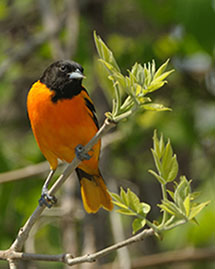The month of April is like a firework presentation, starting slowly and building into a spectacular finale. Colors begin with early blues and purples of hepaticas and are quickly joined by whites and yellows of spring beauties and trout lilies returning long lost color to the forest floor. The first of several waves of neotropical migrant birds arrive. Some will only rest briefly as they continue on their journey farther north. These colorful gems bring their sweet songs to the developing spring. By the end of the month the color display will be at its peak and the trees will begin to shade the forest floor, shifting the wildflower’s energy to seed production.
Birds
 Riding nighttime southerly winds the first waves of warblers, sparrows and thrushes arrive on the north coast stopping in Ohio only to refuel before continuing their journey north. Some champions of migration can be found in April as shorebirds that have spent our winter as far south as Argentina, briefly stop at local mudflats to refuel on invertebrates before continuing to the tundra of Canada. Others like orioles, grosbeaks and tanagers return to local Ohio to begin their nesting cycle while common grackles, mourning doves and American woodcocks already having hatched and fledged one brood by the end of the month.
Riding nighttime southerly winds the first waves of warblers, sparrows and thrushes arrive on the north coast stopping in Ohio only to refuel before continuing their journey north. Some champions of migration can be found in April as shorebirds that have spent our winter as far south as Argentina, briefly stop at local mudflats to refuel on invertebrates before continuing to the tundra of Canada. Others like orioles, grosbeaks and tanagers return to local Ohio to begin their nesting cycle while common grackles, mourning doves and American woodcocks already having hatched and fledged one brood by the end of the month.
Wildflowers
The race is on! Ephemeral spring wildflowers bloom and are pollinated before the leaves of trees shade the forest floor. Early in the month hepatica highlights the grey brown of the forest floor with purple even before new leaves appear. Soon to bloom are the yellow of trout lilies among the whites of squirrel corn and Dutchman’s breeches; by the end of the month white and purple trillium come into bloom. West side reservations bloom before the east, providing those willing to travel a brief extension of this fleeting season.
Reptiles
On warm sunny April days the first snakes can be seen out of hibernation. Often still covered in mud from underground hibernacula, northern water snakes warm themselves on wetland edges melting away the chill of a long hibernation. In meadows, garter snakes and northern brown snakes are becoming become active often seen warming themselves on pavement or the All Purpose Trails. This is a good time to see black rat snakes before the leaves conceal their presence amongst the tree branches.
Amphibians
The early rush to vernal pools is now replaced with the slower and more prolonged breeding season of America toads, leopard and pickerel frogs. America toads are extreme egg layers where one female can lay up to 15,000 eggs in a long coiled string often extending over 10 meters in length. The snoring sounds of leopard and pickerel frogs can be difficult for some to distinguish but typically can be geographically separated with leopard frogs in the west and pickerel frogs in the east. Their tadpoles will develop quickly to emerge as froglets before the end of summer.